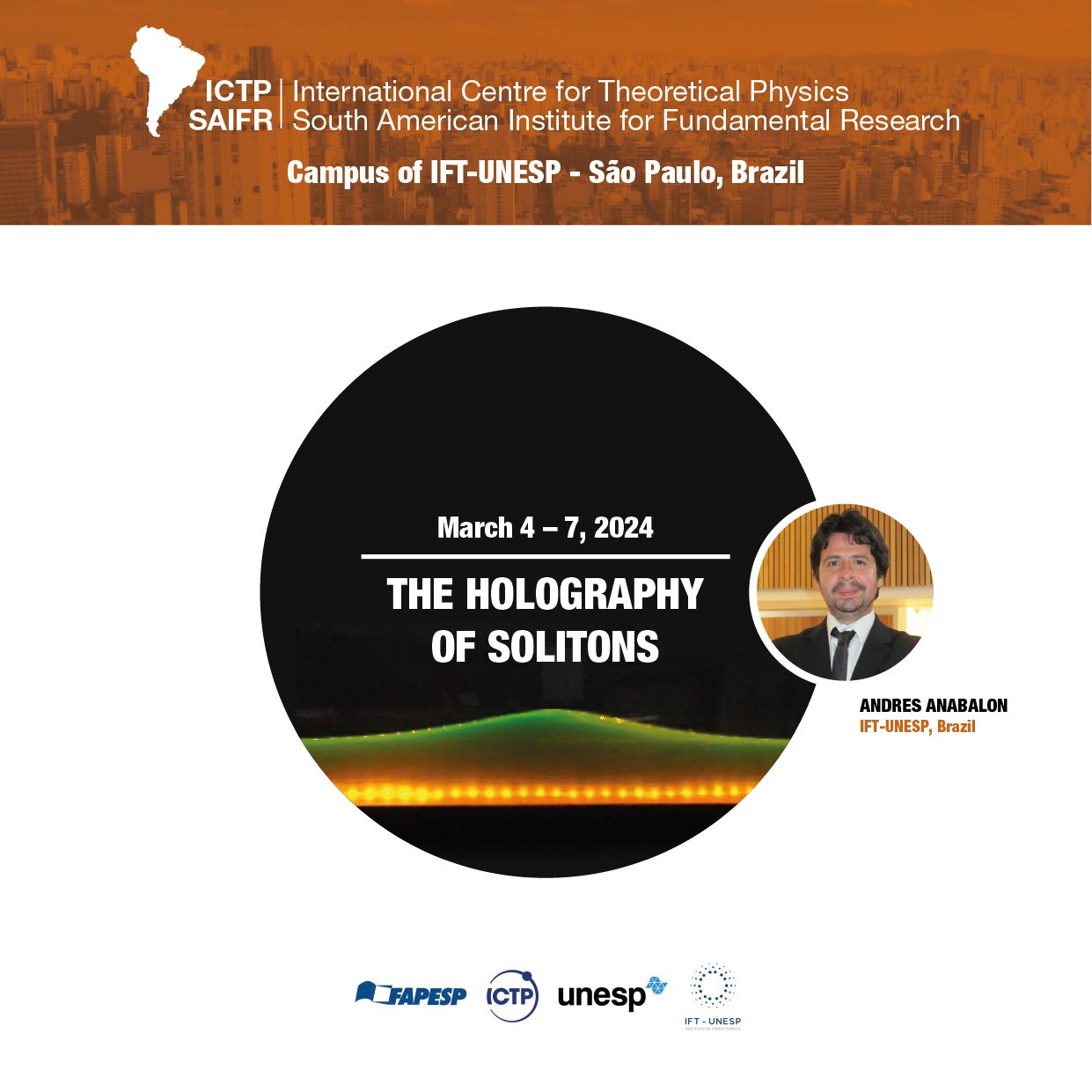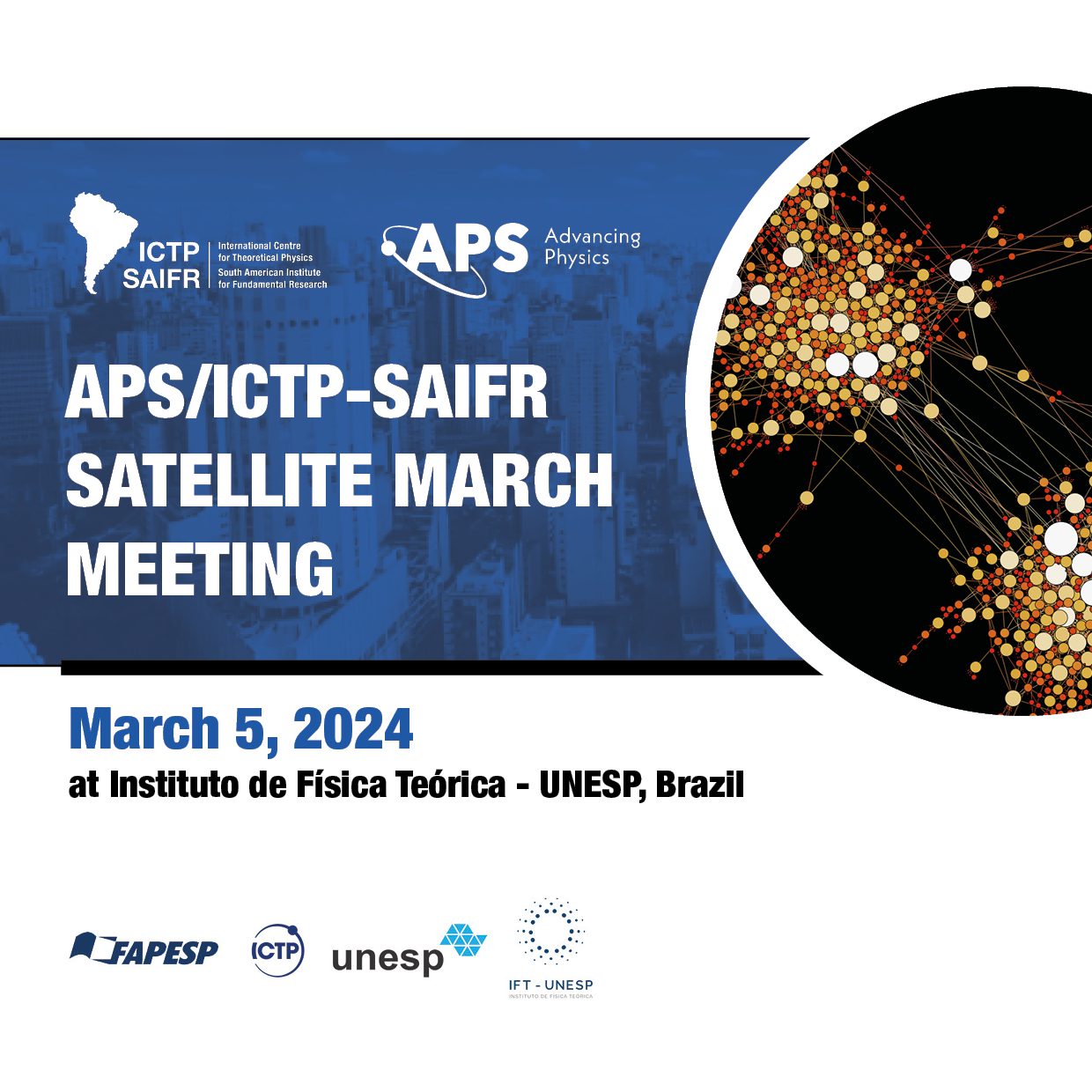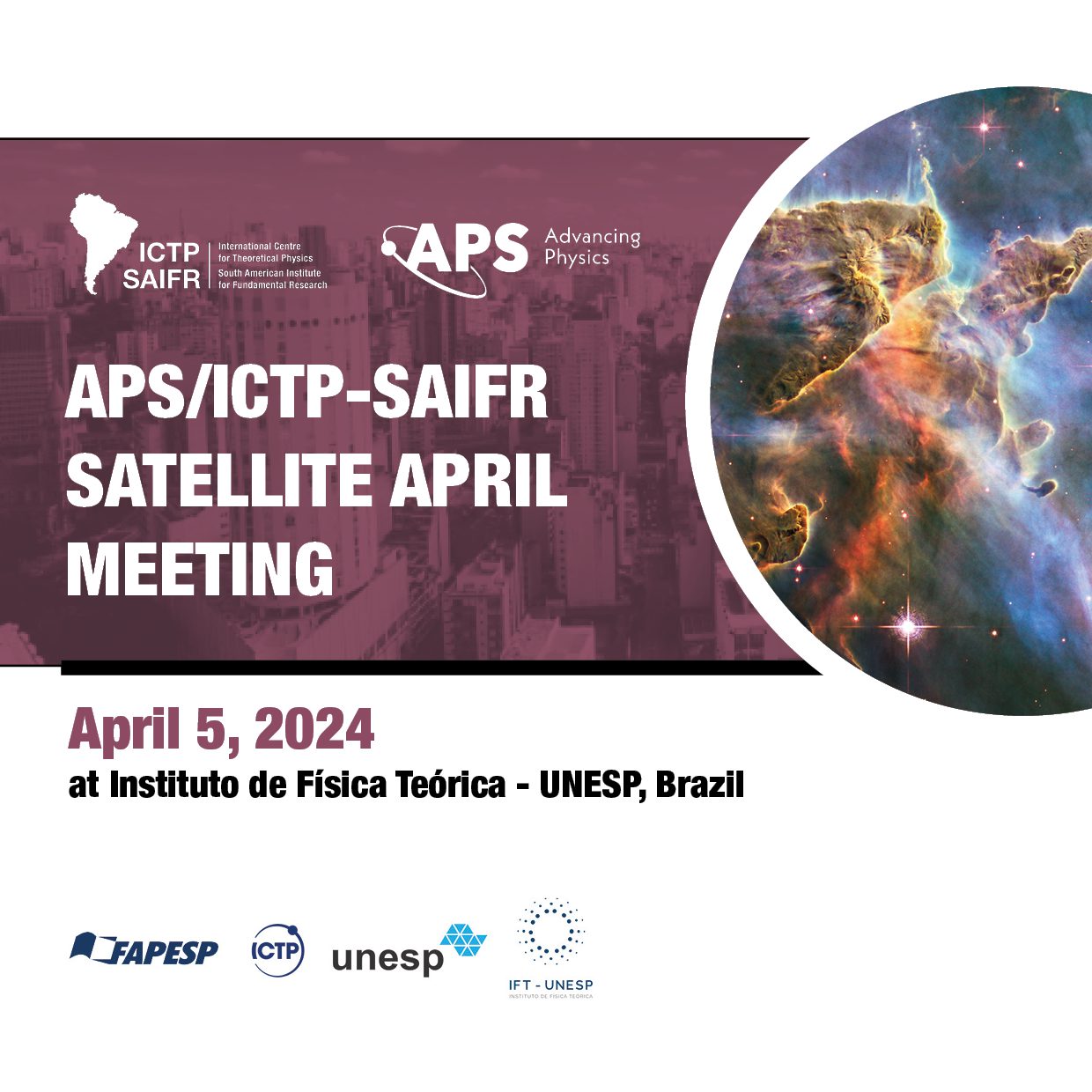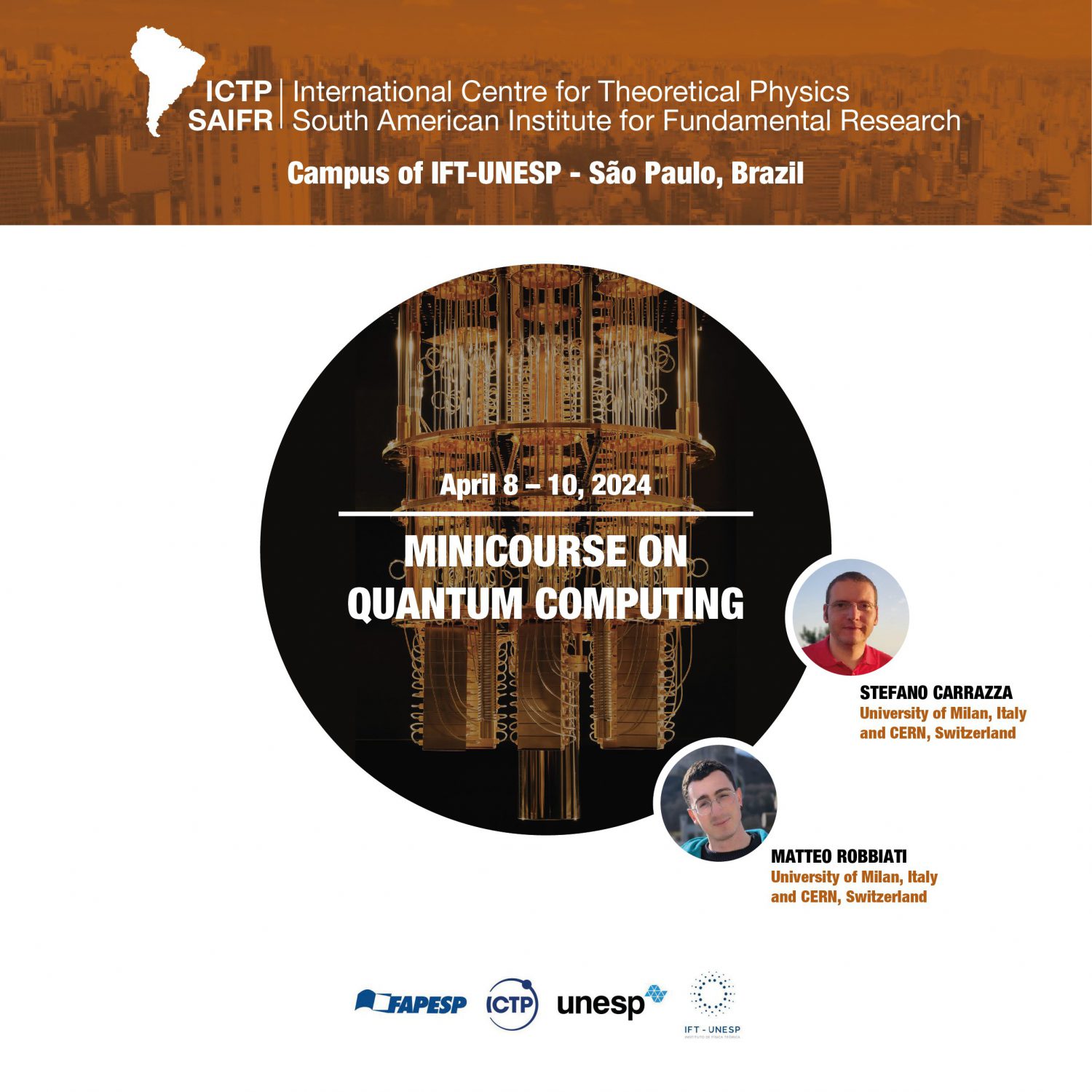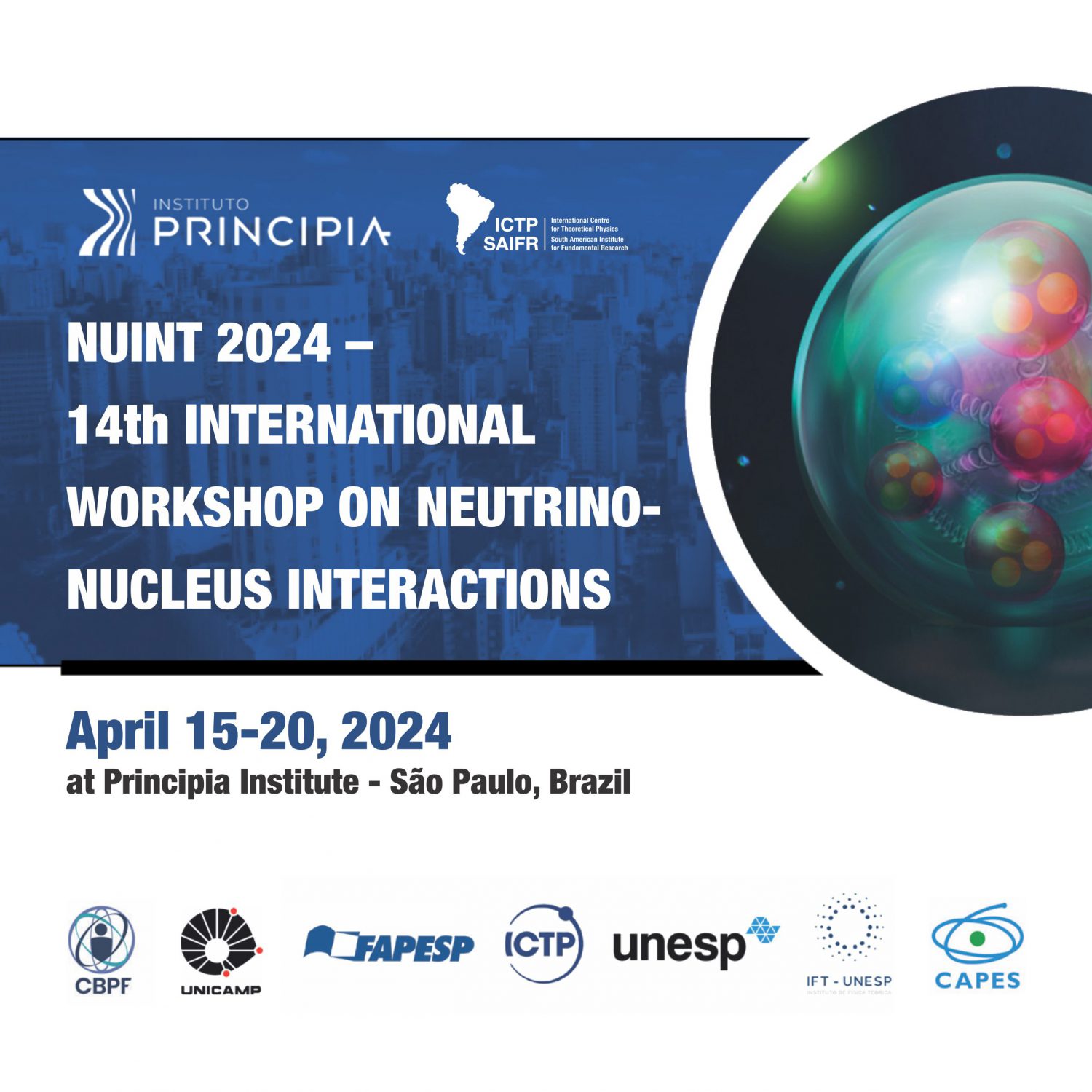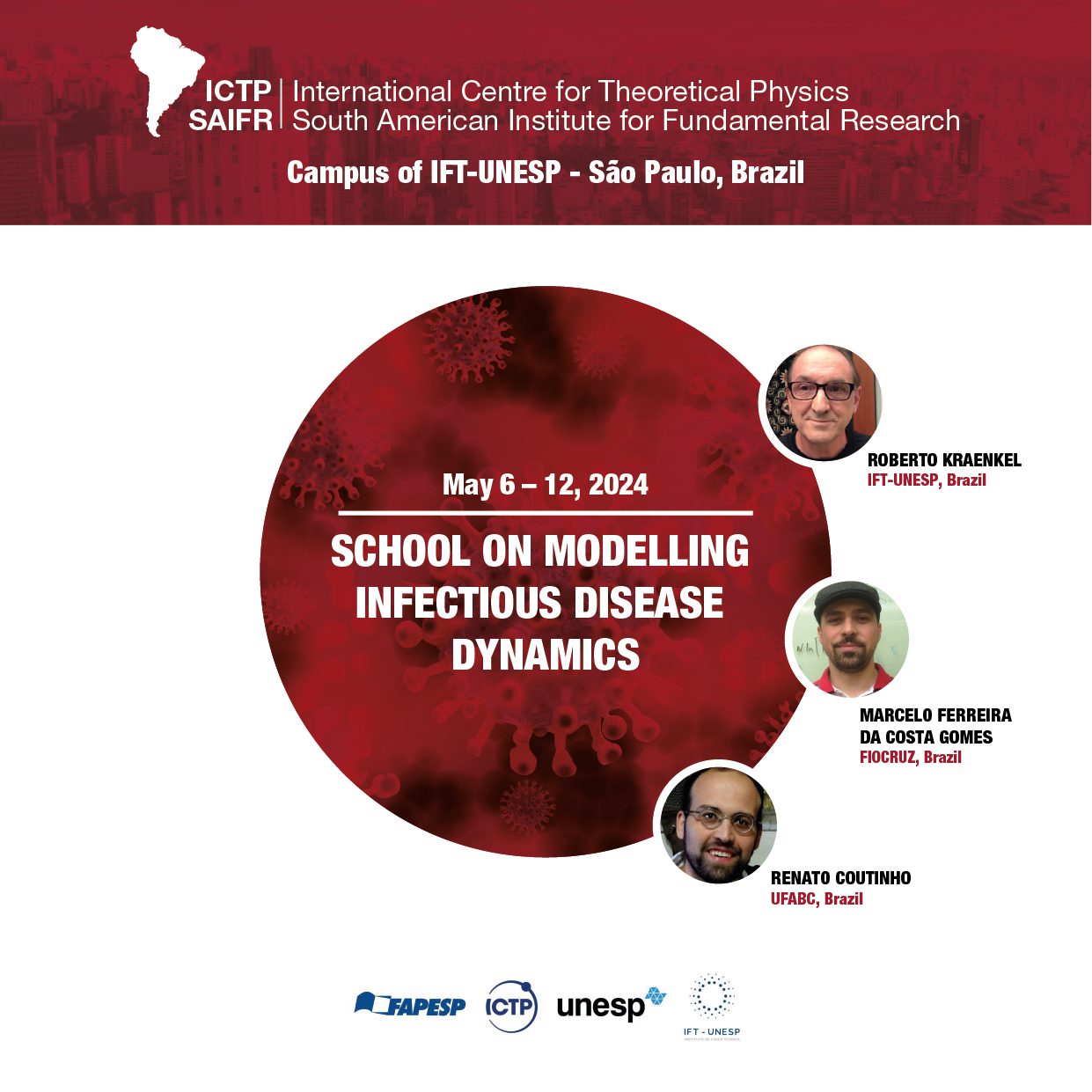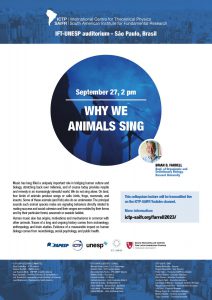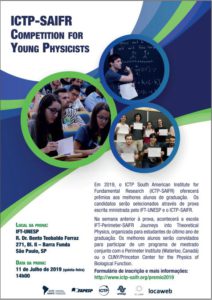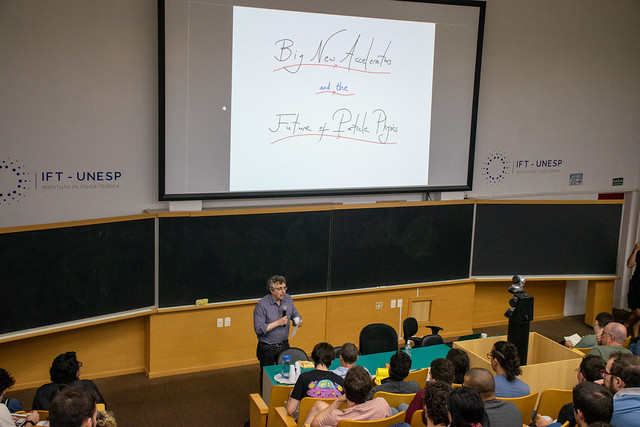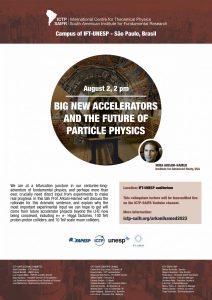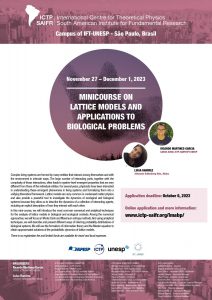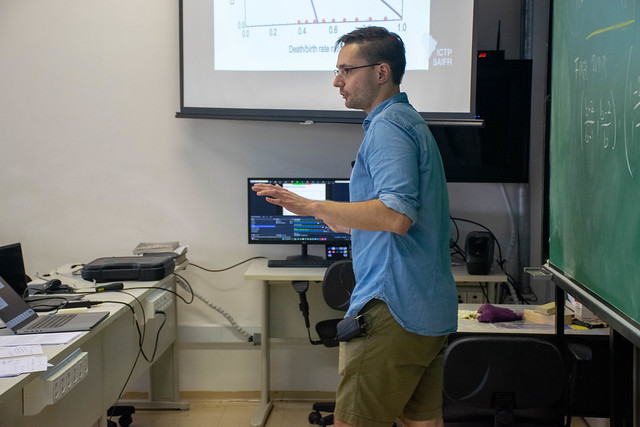Search Results
Próximos eventos de pesquisa
Continue Reading |
Comments Off on
Postdoc/Group leader in non-equilibrium quantum many body theory at ICTP-SAIFR (São Paulo) and NEUQUAM (Mainz)
We are looking for a researcher to lead a team on non-equilibrium quantum many body theory at the ICTP-SAIFR center in São Paulo, who will work in close collaboration with Prof. J. Marino and his team (NEUQUAM) at the University of Mainz in Germany (https://sites.google.com/view/nequantumuniv). Our medium-term goal is to establish a small research group at ICTP-SAIFR working on quantum dynamics of many-particles systems.
The selected candidate will receive a postdoctoral fellowship from the São Paulo State Research Funding Agency (FAPESP), and will have access to ICTP-SAIFR and NEUQUAM funding for travel and visitors. Qualified/experienced candidates can also apply for a more senior position as Young Investigator Fellow (FAPESP). The fellowship is for 3 to 5 years, and includes the possibility of spending one year as a visitor of Prof. Marino’s group in Germany. The researcher will also be able to collaborate with the CMSP Section of The Abdus Salam International Centre for Theoretical Physics in Trieste (https://www.ictp.it/cmsp). In addition, funding for Master´s and PhD students is available through Brazilian funding agencies. The team will be located at the Institute for Theoretical Physics of UNESP in downtown São Paulo. The group leader hired with this call, and their PhD students, will be officially affiliated to the NEUQUAM group in Mainz, with the possibility to access local computing resources and facilities.
The selected candidate should have a background in the dynamics of quantum many body problems, with expertise in one or more of these areas: quantum optics; cold atoms; open quantum systems; dynamics of quantum information; quantum circuits and devices; strongly correlated systems; condensed matter physics; field theory methods for many-particle systems.
The researcher will be able to receive extensive training in analytical and numerical methods as well as mentorship in team leading skills by working in close collaboration with Prof. Marino. The goal is to establish at ICTP-SAIFR an expertise in modern topics in the field of non-equilibrium many body systems, with focus on (i) strongly correlated many body cavity QED, (ii) quantum information at the interface of solid state and quantum optics, and (iii) control of NISQ devices. The appointed candidate should be a highly-motivated, qualified, and independent researcher, with the long-term career goal of leading a group on non-equilibrium quantum dynamics in South America.
Review of the applications will start immediately, and job interviews will be held approximately every 3 weeks until the position is filled. Interested candidates should arrange for the following application material to be sent to dissipativequantummanybodyjgu@gmail.com
1) curriculum vitae (highlighting 3-4 key publications);
2) full list of publications;
3) names and e-mail contacts of 3 researchers for reference letters;
4) a motivation letter of 2 pages which addresses in details the key items of this call, with links to previous research experience of the candidate.
ICTP-SAIFR is committed to increasing the proportion of underrepresented minorities in science.
Continue Reading |
Comments Off on
Colloquium – Why We Animals Sing

![]()
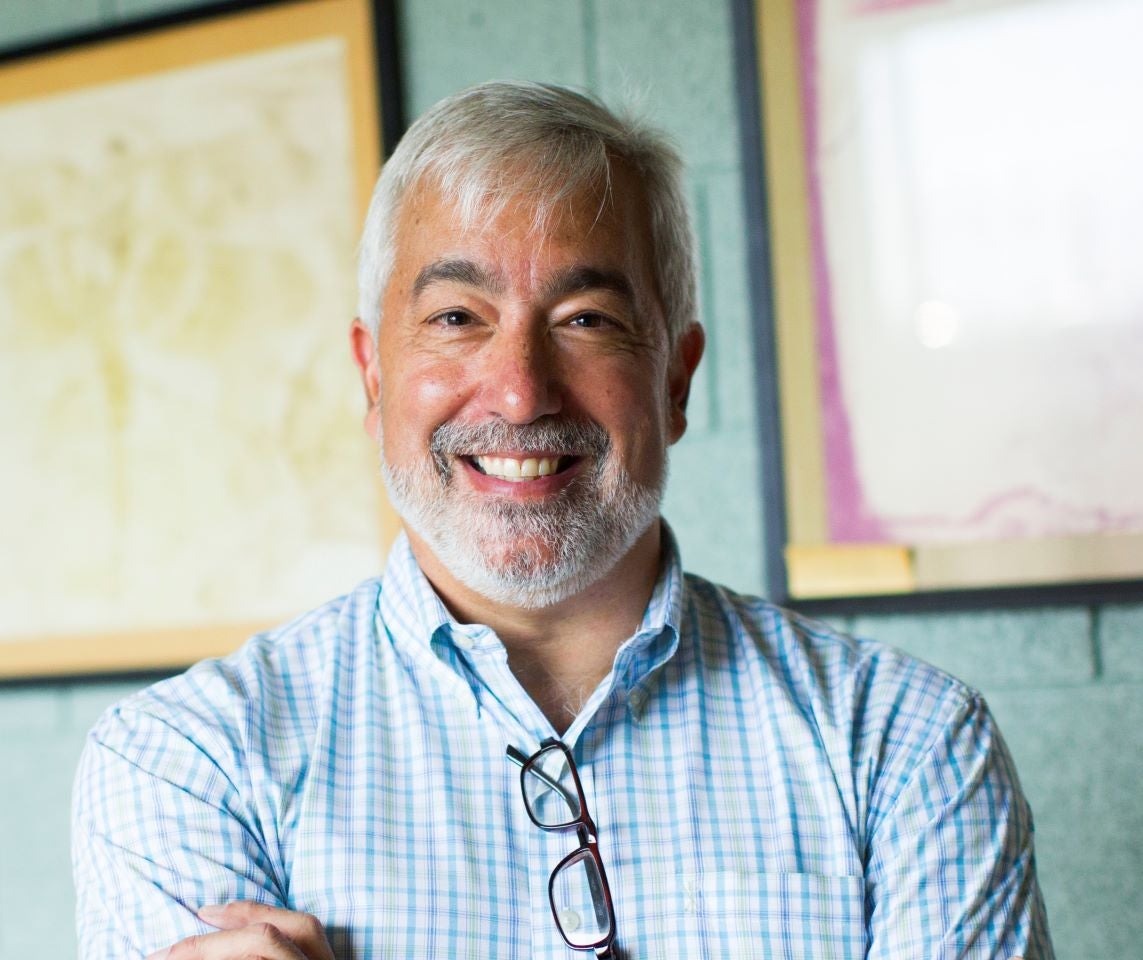
Lecturer: Brian D. Farrell (Dept. of Organismic and Evolutionary Biology, Harvard Univ.)
Date: September 27, 2023 (Wednesday)
Schedule: 2pm
Location: IFT-UNESP auditorium (Barra Funda, São Paulo)
Abstract: Music has long filled a uniquely important role in bridging human culture and biology, stretching back over millennia, and of course today provides respite and remedy in an increasingly stressful world. We do not sing alone. On land, four kinds of animals produce songs or calls: birds, frogs, mammals, and insects. Some of these animals (and fish) also do so underwater. The principal sounds such animal species make are signaling behaviors directly related to mating success and social cohesion and their ranges are molded by their forms and by their particular forest, savannah or seaside habitat.
Human music also has origins, motivations and mechanisms in common with other animals. Traces of a long and ongoing history comes from archaeology, anthropology and brain studies. Evidence of a measurable impact on human biology comes from neurobiology, social psychology, and public health.
Brian D. Farrell is the Monique and Philip Lehner Professor for the Study of Latin America at the Department of Organismic and Evolutionary Biology in Harvard University, and is the Curator in Entomology at the Museum of Comparative Zoology. He served as Director of the David Rockefeller Center for Latin American Studies from 2014-2020. There is no need to register to attend the colloquium in the IFT-UNESP auditorium, which will also be transmitted live by YouTube.
Live streaming:
Poster:
Continue Reading |
Comments Off on
Professora do IFT-Unesp recebe prêmio internacional na área de Ciência das Redes Complexas
Hilda Cerdeira foi homenageada em conferência latino-americana
Por Felipe Saldanha
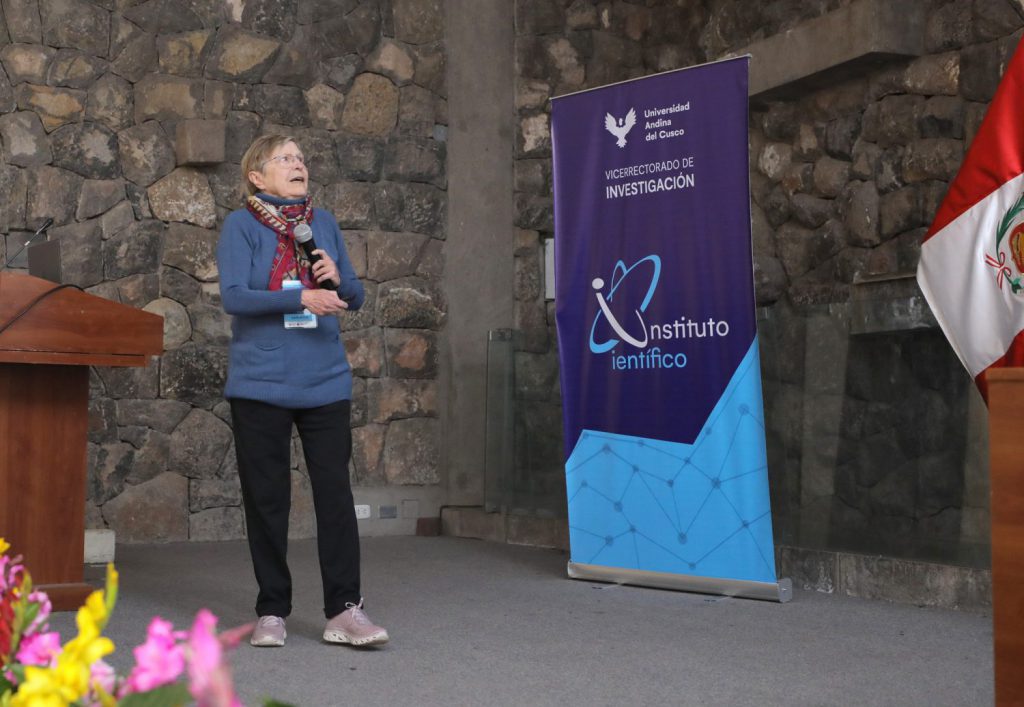
A docente tem desenvolvido pesquisas sobre sistemas dinâmicos não lineares e colaborado com cientistas de países em desenvolvimento (Foto: Divulgação/Universidade Andina de Cusco)
A professora Hilda Alicia Cerdeira, do Instituto de Física Teórica (IFT) da Unesp, recebeu um prêmio internacional em reconhecimento ao seu trabalho na área de Ciência das Redes Complexas e Sistemas Não Lineares. O LANET Award 2022 foi concedido à docente no dia 22 de agosto de 2023, durante a terceira edição da Conferência Latino-Americana de Redes Complexas (LANET), realizada em Cusco (Peru).
O diploma entregue à professora enfatiza “suas inestimáveis contribuições à Análise de Sistemas Dinâmicos Não Lineares e Redes por toda a região da América Latina”. Trata-se de um campo que descreve redes complexas e, como explica Hilda Cerdeira, possui inúmeros objetos de estudo, como redes elétricas, a internet, agrupamentos de seres vivos, movimentos de aviões e jogos de futebol. “Uma rede é um conjunto de nós e conexões e estas últimas não são necessariamente uma coisa física, mas podem ser simplesmente uma interação que você pode descrever matematicamente”, afirma.
A premiação também destacou “sua incansável dedicação em promover a educação e o empoderamento de jovens pesquisadores na área”. A docente conta que, já há algumas décadas, tem se dedicado a colaborar com físicos da América Latina, África e Ásia, promovendo aproximações entre eles. A atuação direcionada a cientistas de nações em desenvolvimento, inclusive, já havia garantido a ela o prêmio Espírito de Abdus Salam de 2021, concedido pelo Centro Internacional de Física Teórica (ICTP), na Itália. “Como eu tenho feito durante muito tempo esse tipo de trabalho, parece que tenho tocado muitas pessoas”, reconhece.
Argentina naturalizada brasileira, Hilda Cerdeira é doutora pela Universidade Brown (EUA), fez pós-doutorado na Alemanha e trabalhou na Universidade Estadual de Campinas e no ICTP da Itália, antes de se tornar professora do IFT. Ela integrou o comitê consultivo da revista Physics Today e é revisora de diversos periódicos da área. Também é sócia fundadora de uma startup, na qual aplica na área da saúde o resultado de suas pesquisas sobre redes.
Ao longo dos últimos anos, a docente co-organizou uma série de escolas sobre sistemas dinâmicos não lineares junto ao ICTP-SAIFR, centro internacional sediado no IFT-Unesp, que abordaram aspectos diversos como ótica e nanofotônica, redes complexas e neurociência, análise de séries temporais, complexidade socioeconômica, teoria da informação e aprendizado de máquina, além de uma escola iniciada em agosto sobre caos quântico.
Criada em 2017, a LANET tem o objetivo de proporcionar um fórum estável e periódico para reunir todos os cientistas que de alguma forma estejam relacionados com os estudos em Ciência das Redes na América Latina, estimulando a formação de grupos interessados na área e ajudando a estabelecê-la como uma disciplina nas universidades e instituições de pesquisa latino-americanas.
Felipe Saldanha é jornalista de ciência do ICTP-SAIFR com bolsa Fapesp.
Continue Reading | Comments Off on Professora do IFT-Unesp recebe prêmio internacional na área de Ciência das Redes Complexas
ICTP-SAIFR Competition for Young Physicists
![]()
Informações
Cada ano, o ICTP South American Institute for Fundamental Research (ICTP-SAIFR) oferece bolsas e prêmios aos melhores alunos de graduação. Os candidatos são selecionados através de prova escrita ministrada pelo IFT-UNESP e o ICTP-SAIFR. A prova escrita é aplicada na cidade de São Paulo no prédio do IFT-UNESP ao lado do metrô Barra Funda. As perguntas são escritas em inglês, mas as respostas podem ser em inglês ou português.
Data da prova em 2023: 22 de Julho de 2023 (sábado), 14h00
Local da prova: IFT-UNESP (auditório no quarto andar) – Instruções: como chegar
R. Dr. Bento Teobaldo Ferraz 271, Bl. II – Barra Funda – São Paulo, SP.
Na semana anterior à prova, acontece a escola IFT-Perimeter-SAIFR Journeys into Theoretical Physics, organizada para estudantes do último ano de graduação. Os melhores alunos são convidados para participar de um programa de mestrado conjunto com o Perimeter Institute (Waterloo, Canadá) ou o CUNY/Princeton Center for the Physics of Biological Function. Maiores informações sobre esta escola podem ser encontradas na página: http://www.ictp-saifr.org/journeys
Candidatos aprovados para o Perimeter-SAIFR-IFT Journeys into Theoretical Physics estão automaticamente inscritos para o 2023 ICTP-SAIFR Competition for Young Physicists.
Regulamento
Da inscrição:
Os candidatos devem estar regularmente matriculados em um curso de graduação.
As inscrições são feitas online e devem conter nome, data de nascimento, número do RG, e universidade.
Da prova:
A prova escrita tem duração de 3 1/2 horas, e versa sobre as seguintes matérias do curso de graduação em Física: Mecânica Clássica, Mecânica Quântica, Mecânica Estatística/Termodinâmica, Eletromagnetismo, Relatividade Especial e Física-Matemática.
Apenas os candidatos devidamente inscritos e munidos de R.G. ou documento equivalente (com foto) podem fazer a prova.
Durante a prova não é permitido o uso de qualquer tipo de notas, livros, computador, ou calculadora.
Cartaz
Ganhadores & Provas anteriores
Nomes dos Ganhadores do 2012 Prêmio IFT-ICTP para Jovens Físicos
Nomes dos Ganhadores do 2013 Prêmio IFT-ICTP para Jovens Físicos
Nomes dos Ganhadores do 2014 Prêmio IFT-ICTP para Jovens Físicos
Nomes dos Ganhadores do 2015 Prêmio IFT-ICTP para Jovens Físicos
Nomes dos Ganhadores do 2016 Prêmio IFT-ICTP para Jovens Físicos
Nomes dos Ganhadores do 2017 Prêmio IFT-ICTP para Jovens Físicos
Nomes dos Ganhadores das Bolsas 2018 ICTP-SAIFR para Jovens Físicos
Nomes dos Ganhadores das Bolsas 2019 ICTP-SAIFR para Jovens Físicos
Nomes dos Ganhadores das Bolsas 2022 ICTP-SAIFR para Jovens Físicos
Nomes dos Ganhadores do 2023 Prêmio SAIFR para Jovens Físicos
Provas anteriores:
Continue Reading |
Comments Off on
Ganhadores do 2023 Prêmio SAIFR para Jovens Físicos
O ICTP South American Institute for Fundamental Research (ICTP-SAIFR) oferece prêmios em 2023 aos melhores alunos de graduação. Os cinco ganhadores foram selecionados através de prova escrita ministrada pelo IFT-UNESP e o ICTP-SAIFR. A entrega dos prêmios vai ser no auditório do IFT-UNESP antes da aula inaugural de 2024.
Ganhadores do 2023 Prêmio SAIFR para Jovens Físicos
1º Lugar: R$ 1.000,00
Francisco Divi (Balseiro Institute, Argentina), 74.5 de 100 pontos
2º Lugar: R$ 800,00
Matheus Balisa Pauliquevis (USP São Paulo), 56.5 de 100 pontos
3º Lugar: R$ 600,00
Carlo de Castro Bellinati (USP São Paulo), 55.5 de 100 pontos
4º Lugar: R$ 400,00
Gabriel Capelo Domingues (USP São Carlos), 48 de 100 pontos
5º Lugar: R$ 200,00
Vicente Viater Figueira (USP São Paulo), 47.5 de 100 pontos
5º Lugar: R$ 200,00
Levy Bruno do Nascimento Batista (USP São Carlos), 47.5 de 100 pontos
Continue Reading | Comments Off on Ganhadores do 2023 Prêmio SAIFR para Jovens Físicos
ICTP-SAIFR anuncia ganhadores de prêmio em Gravidade Clássica em 2023
Teses agraciadas abordam Princípio Copernicano, teorias alternativas de gravidade e detectores de ondas gravitacionais
Por Felipe Saldanha
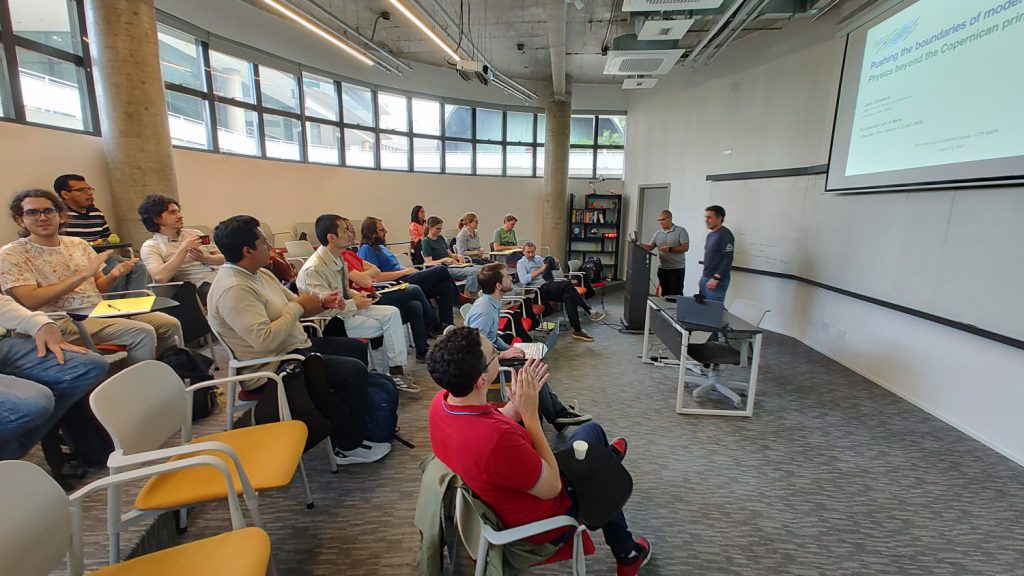
David Camarena (no púlpito), autor da tese vencedora, recebeu certificado da premiação durante evento internacional em São Paulo (Foto: Thiago Codinhoto)
Foram anunciados os ganhadores da edição de 2023 do ICTP-SAIFR Prize in Classical Gravity and Applications, prêmio que reconhece pesquisas de teses de doutorado destacadas que promovem avanços na área de Gravidade Clássica e suas aplicações em Física de Ondas Gravitacionais, Astrofísica e Cosmologia.
O vencedor é David Camarena, doutor pelo Programa de Pós-Graduação em Astrofísica, Cosmologia e Gravitação (PPGCosmo) da Universidade Federal do Espírito Santo (Ufes) em 2022. Atualmente, ele é pesquisador de pós-doutorado na Universidade do Novo México (EUA). Sua tese propõe expandir as fronteiras da Cosmologia moderna para além do Princípio Copernicano, o qual presume que a Terra não ocupa lugar especial no universo. A pesquisa busca testar observacionalmente esse princípio e prever como futuros levantamentos astronômicos poderão detectar possíveis violações a ele.
O prêmio concedeu também menções honrosas. Guilherme Brando de Oliveira, doutor pelo PPGCosmo da Ufes em 2022 e pesquisador de pós-doutorado do Instituto Max Planck de Física Gravitacional (Alemanha), foi um dos agraciados. Em sua pesquisa doutoral, ele investigou teorias alternativas de gravidade para além do Modelo Padrão da Cosmologia, com o uso de ferramentas de matemática linear e não linear. Outro a receber menção honrosa foi Luís Felipe Longo Micchi, doutor pelo Programa de Pós-Graduação em Física da Universidade Federal do ABC em 2023 e assistente científico na Universidade Friedrich Schiller em Jena (Alemanha). Na tese, ele estuda dois tipos de fontes da terceira geração de detectores diretos de ondas gravitacionais, provenientes de buracos negros e estrelas de nêutrons.
O prêmio incluiu o convite para participar de um programa internacional sobre ondas gravitacionais que acontece neste mês de agosto em São Paulo, durante o qual as pesquisas premiadas foram apresentadas. Para David Camarena, o prêmio e a participação no evento impactaram de maneira abrangente o desenvolvimento de sua carreira e pesquisa. “No curto prazo, ampliou a visibilidade do meu trabalho, permitindo interações com destacados pesquisadores no campo da gravitação e suas aplicações, além de fortalecer as conexões com colaboradores de instituições brasileiras. No longo prazo, acredito que esse reconhecimento aumentará ainda mais o valor da minha pesquisa, abrindo portas para novas oportunidades nesta área”, destaca o pesquisador.
Na mesma linha, Luís Felipe Micchi acredita que a menção honrosa o ajuda a ganhar visibilidade internacional. “No mundo acadêmico, essa visibilidade é extremamente importante, uma vez que as colaborações em investigação são essenciais para a consolidação de uma carreira de sucesso. Em nível pessoal, acredito que esse prêmio ajuda (ex-)estudantes de pós-graduação, como eu, a ganhar autoconfiança no seu trabalho e a lidar com a síndrome do impostor que aflige muitos desses estudantes”, afirma.
Sobre o prêmio
O ICTP-SAIFR Prize in Classical Gravity and Applications recebe nomeações de teses doutorais de qualquer país da América Latina, normalmente feitas pelo orientador do trabalho. Os candidatos precisam ter defendido não mais de 18 meses antes do prazo de indicação. Cada autor pode ser nomeado apenas uma vez, mas os candidatos que não forem aprovados serão reconsiderados no ano seguinte.
Os nomeados são avaliados por um comitê internacional, que neste ano incluiu Vitor Cardoso, da Universidade de Lisboa (Portugal); Rodrigo Fernandez, da Universidade de Alberta (Canadá); Walter Goldberger, da Universidade Yale (EUA); Gabriela Gonzalez, da Universidade do Estado da Louisiana (EUA); e Luis Lehner, do Instituto Perimeter (Canadá).
O vencedor recebe R$ 1.000 e, junto aos agraciados com menção honrosa, certificado e convite para palestrar em um evento anual do ICTP-SAIFR, com todas as despesas pagas. Os vencedores das edições anteriores e mais informações sobre o prêmio estão disponíveis no site ictp-saifr.org/gravityprize. A previsão é que as inscrições para a próxima edição sejam abertas no início de 2024, com prazo para submissão até 30 de abril.
Felipe Saldanha é jornalista de ciência do ICTP-SAIFR com bolsa Fapesp.
Continue Reading | Comments Off on ICTP-SAIFR anuncia ganhadores de prêmio em Gravidade Clássica em 2023
2023 Workshop on Classical Gravity

August 16, 2023
ICTP-SAIFR, São Paulo, Brazil
Principia Institute
Home
Fundamental gravity, astronomy and cosmology have experienced unprecedented new developments and Gravitational Waves is a relatively recent actor on the stage. New observations of transients of electromagnetic, cosmic rays and neutrino origin are expected in the next decade, which will serve as cosmological probes as well as cosmic laboratories of strong gravity and high-energy physics. The high level of coordination required to maximize the (astro)physics output of forthcoming observations makes it timely to explore the cross-correlation among these different probes of astronomy, cosmology and fundamental gravity.
The aim of this workshop is to further stimulate activities in the Latin-American community in these rapidly evolving research areas related to classical gravity, to strengthen and spur new connections and collaborations, and to award the 2023 ICTP-SAIFR Prizes for the best Latin-American thesis in Classical Gravity and Applications.
The 2023 Workshop on Classical Gravity is a a part of the Gravitational Waves meet Amplitudes in the Southern Hemisphere Program
There is no registration fee.
Organizers:
- Luis Lehner (Perimeter Institute, Waterloo, Canada)
- Riccardo Sturani (IFT-UNESP, São Paulo, Brazil)
Speakers
- Luis Lehner (Perimeter Institute, Canada): Beyond General Relativity and the strongly gravitating/dynamical regime
- Guilherme Brando de Oliveira (UFES, Brazil): The emergence of time in cosmological correlations
- David Camarena (UFES, Brazil): Pushing the boundaries of modern cosmology: physics beyond the Copernican principle
- Luis Felipe Longo Micchi (UFABC, Brazil): Prospective Sources of Gravitational Waves for Third-Generation Ground-Based Observatories
Program
2:00 PM Luis Lehner (Perimeter Institute, Canada): Beyond General Relativity and the strongly gravitating/dynamical regime
3:00 PM Guilherme Brando de Oliveira (UFES, Brazil): The emergence of time in cosmological correlations
4:00 PM David Camarena (UFES, Brazil): Pushing the boundaries of modern cosmology: physics beyond the Copernican principle
4:30 PM Luis Felipe Longo Micchi (UFABC, Brazil): Prospective Sources of Gravitational Waves for Third-Generation Ground-Based Observatories
Videos and Files
2023-08-16
- 14:00 – Luis Lehner (Perimeter Institute, Canada): Beyond General Relativity and the strongly gravitating/dynamical regime
- 15:00 – Guilherme Pimentel (Scuola Normale Superiore – Pisa, Italy): The emergence of time in cosmological correlations
- 16:00 – David Camarena (UFES, Brazil): Pushing the boundaries of modern cosmology: physics beyond the Copernican principle
- 16:30 – Luis Felipe Longo Micchi (UFABC, Brazil): Prospective Sources of Gravitational Waves for Third-Generation Ground-Based Observatories
Photos
Additional Information
BOARDING PASS: All participants, whose travel has been provided or will be reimbursed by ICTP-SAIFR, should bring the boarding pass upon registration. The return boarding pass (PDF, if online check-in, scan or picture, if physical) should be sent to secretary@ictp-saifr.org by e-mail.
COVID-19: Fully vaccinated Brazilians and foreigners are required to present proof of vaccination, printed or electronically before boarding an international flight. Not vaccinated and not fully vaccinated passengers have to present a medical certificate with a negative test result before entering the country. Tests should be taken up to 24 hours before boarding.
Visa information: Nationals from several countries in Latin America and Europe are exempt from tourist visa. Nationals from Australia, Canada, Japan and USA are exempt from tourist visa until October 1st, 2023. Please check here which nationals need a tourist visa to enter Brazil.
Hotel recommendation: http://www.ictp-saifr.org/hotel-recommendations-2. Participants and Speakers whose accommodation will be provided by the institute will stay at The Universe Flat.
How to reach the Principia Institute: The workshop will be held at Principia Institute of the Institute for Theoretical Physics Foundation, located at Rua Pamplona, 145, 50 meters uphill from the hotel Universe Flat.
Continue Reading |
Comments Off on
Colloquium – Big New Accelerators and the Future of Particle Physics
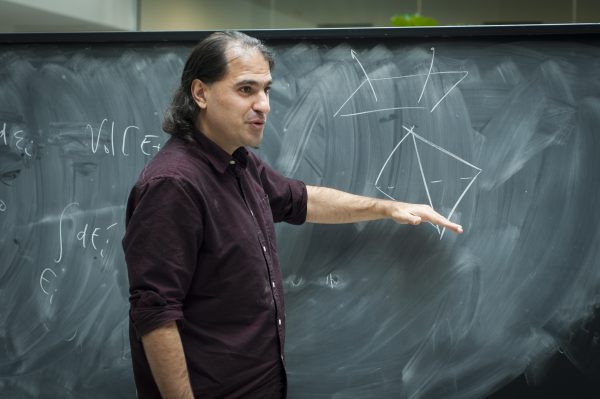
Lecturer: Nima Arkani-Hamed – IAS Princeton
Date: August 2, 2023 (Wednesday)
Schedule: 2pm
Location: IFT-UNESP auditorium (Barra Funda, São Paulo)
Abstract: We are at a bifurcation juncture in our centuries-long-adventure of fundamental physics, and perhaps more than ever, crucially need direct input from experiments to make real progress. In this talk I will discuss the rationale for this dramatic sentence, and explain why the most important experimental input we can hope to get will come from future accelerator projects beyond the LHC now being conceived, including e+ e- Higgs factories, 100 TeV proton-proton colliders, and 10 TeV scale muon colliders.
Prof. Arkani-Hamed is a leading theoretical particle physicist and recipient of numerous prizes including the Gribov Medal (2005), the Sackler Prize (2008), the Breakthrough Prize (2012) and the Sakurai Prize (2022). There is no need to register to attend the colloquium in the IFT-UNESP auditorium, which will also be transmitted live by YouTube.
Live streaming:
Photos:
Poster:
Continue Reading |
Comments Off on
Minicourse on Lattice models and applications to biological problems
November 27 – December 1, 2023
São Paulo, Brazil
ICTP-SAIFR/IFT-UNESP

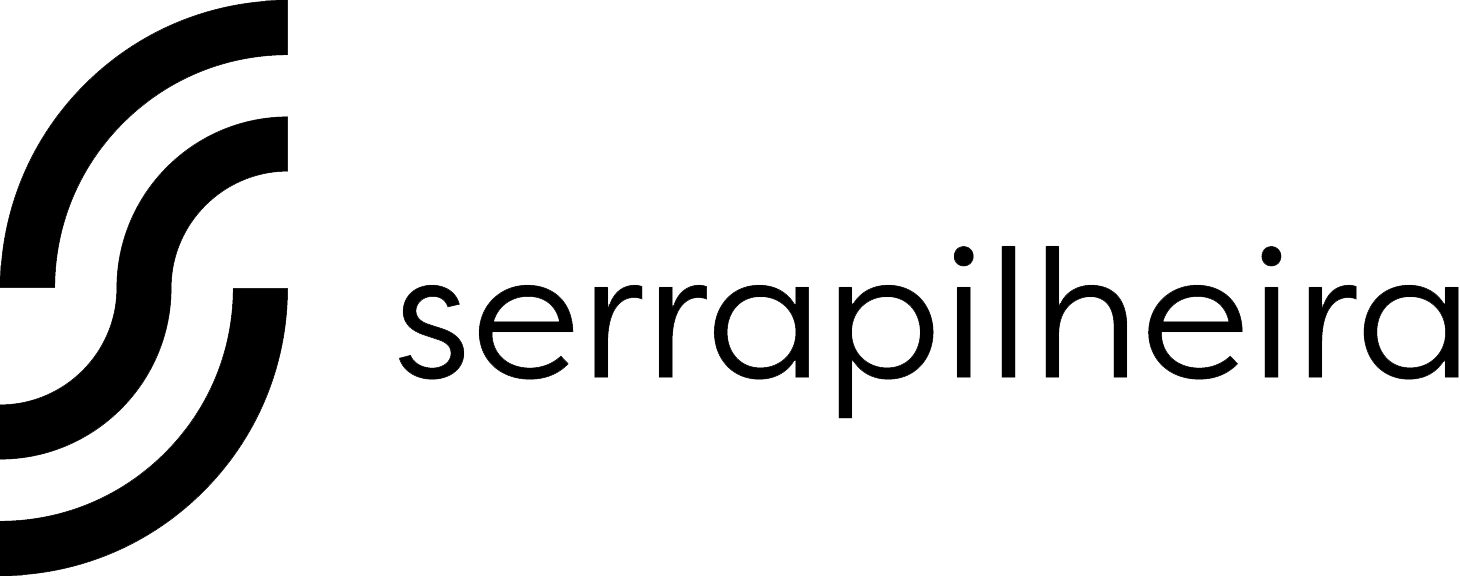
Home
Complex living systems are formed by many entities that interact among themselves and with the environment in intricate ways. The large number of interacting parts, together with the complexity of those interactions, often leads to system-level emergent properties that are very different from those of the individual entities. For several years, physicists have been interested in understanding these emergent phenomena in living systems and formalizing them into a unifying theoretical framework. Lattice models are very common in condensed matter physics and also provide a powerful tool to investigate the dynamics of ecological and biological systems because they allow us to describe the dynamics of a collection of interacting agents, including an explicit description of how they interact with each other.
In this mini-course, we will introduce the most common numerical and analytical techniques for the analysis of lattice models in biological and ecological contexts. Among the numerical approaches, we will focus on Monte Carlo and Maximum entropy methods. And using analytical techniques, we will describe and present different ways of inferring probability distributions of biological systems. We will use the formalism of information theory and the Master equation to obtain approximated solutions of the probabilistic dynamics of lattice models.
There is no registration fee and limited funds are available for travel and local expenses.
Organizers:
- Ricardo Martinez-Garcia (CASUS-HZDR, Germany & ICTP-SAIFR/IFT-UNESP, Brazil)
- Luisa Ramirez (Johannes Guttenberg Univ.,Mainz, Germany)
List of Participants: Updated on November 29, 2023.
Survey: Here
Lecturers
Lecturers:
- Ricardo Martinez-Garcia (CASUS-HZDR, Germany & ICTP-SAIFR/IFT-UNESP, Brazil)
- Luisa Ramirez (Johannes Guttenberg Univ.,Mainz, Germany)
Registration
Program
Download PDF version: HERE
Videos and Files
-
11:00 - Luisa Ramirez (Johannes Guttenberg Univ.,Mainz, Germany):
Learning probability distributions of neuronal activity patterns: Modelling neurons
-
14:00 - Ricardo Martinez-Garcia (CASUS-HZDR, Germany & ICTP-SAIFR/IFT-UNESP, Brazil):
Understanding the role of space in ecological dynamics. From spins to organisms
-
09:00 - Luisa Ramirez (Johannes Guttenberg Univ.,Mainz, Germany):
Learning probability distributions of neuronal activity patterns: Pairwise models of neuronal activity
-
11:00 - Ricardo Martinez-Garcia (CASUS-HZDR, Germany & ICTP-SAIFR/IFT-UNESP, Brazil):
Understanding the role of space in ecological dynamics. Master equations for population dynamics
-
09:00 - Luisa Ramirez (Johannes Guttenberg Univ.,Mainz, Germany):
Learning probability distributions of neuronal activity patterns: Max entropy models
-
11:00 - Ricardo Martinez-Garcia (CASUS-HZDR, Germany & ICTP-SAIFR/IFT-UNESP, Brazil):
Understanding the role of space in ecological dynamics. Implementing efficient numerical simulations
-
09:00 - Luisa Ramirez (Johannes Guttenberg Univ.,Mainz, Germany):
Learning probability distributions of neuronal activity patterns
-
11:00 - Ricardo Martinez-Garcia (CASUS-HZDR, Germany & ICTP-SAIFR/IFT-UNESP, Brazil):
Understanding the role of space in ecological dynamics. Mean-field and higher-order analytical approximations
asdasdasd
Photos
Additional Information
BOARDING PASS: All participants, whose travel has been provided or will be reimbursed by ICTP-SAIFR, should bring the boarding pass upon registration. The return boarding pass (PDF, if online check-in, scan or picture, if physical) should be sent to secretary@ictp-saifr.org by e-mail.
COVID-19: Brazilians and foreigners no longer have to present proof of vaccination before entering the country.
Visa information: Nationals from several countries in Latin America and Europe are exempt from tourist visa. Nationals from Australia, Canada and USA are exempt from tourist visa until January 10, 2024. Please check here which nationals need a tourist visa to enter Brazil.
Accommodation: Participants, whose accommodation will be provided by the institute, will stay at The Universe Flat. Hotel recommendations are available here.
How to reach the Institute: The school will be held at ICTP South American Institute, located at IFT-UNESP, which is across the street from a major bus and subway terminal (Terminal Barra Funda). The address which is closer to the entrance of the IFT-UNESP building is R. Jornalista Aloysio Biondi, 120 – Barra Funda, São Paulo. The easiest way to reach us is by subway or bus, please find instructions here.
Continue Reading |
Comments Off on
